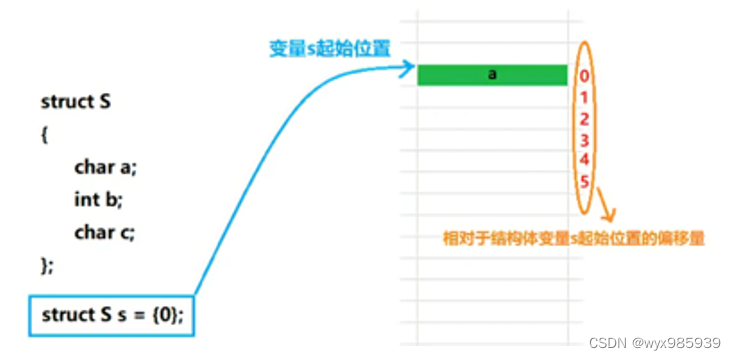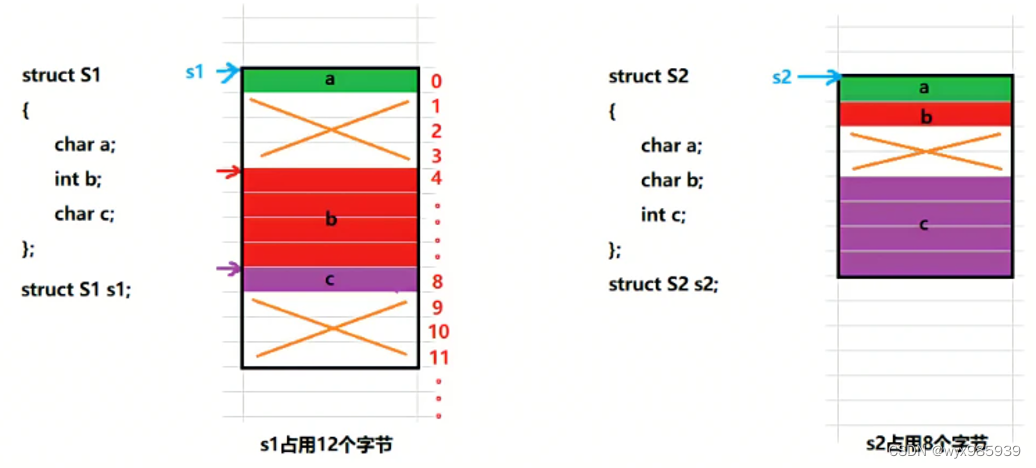结构体的使用
结构体struct
1.结构体的基本用法
1.1 定义
结构体是由一批数据组合而成的结构型数据。组成结构型数据的每个数据称为结构型数据的“成员” ,其描述了一块内存区间的大小及解释意义。
1.2 定义格式
struct 结构体名
{
数据类型 成员变量1;
数据类型 成员变量2;
数据类型 成员变量3;
…
};
举例:构造一个新的数据类型叫student,用来描述学生。
struct student
{
char name[32];
int age;
float score;
};
1.3 结构体变量
1.3.1 概念
通过结构体数据类型定义的变量
1.3.2 格式
struct 结构体名 变量名;
1.3.3 定义结构体变量
(1)先定义结构体,再定义结构体变量。
struct 结构体名
{
成员变量;
};
struct 结构体名 变量名;
例如:
struct student
{
char name[32];
int age;
float score;
};
struct student s1;
(2)定义结构体的同时,定义结构体变量。
struct 结构体名
{
成员变量;
} 变量名;
例如:
struct person
{
char name[32];
int age;
} per1;
也可以缺省结构体名定义结构体变量:
struct
{
成员变量;
} 变量名;
1.3.4 结构体变量赋值
先定义一个结构体:
struct student
{
int id;
char name[32];
int age;
};
(1)定义结构体变量时直接用花括号赋值:
struct student stu1 ={1,“xiaofang”, 18};
(2)定义结构体变量时直接用点等法赋值:
struct student stu2 ={
.id = 2,
.name = “xiaoming”,
.age = 42
};
(3)定义结构体变量时未初始化,需要挨个单独赋值:
struct student stu3;
stu3.id = 3;
stu3.age = 69;
strcpy(stu3.name,“laowang”); 注意字符串以这种方式赋值的话,需要用strcpy
1.3.5 访问结构体成员变量
通过.访问: 结构体变量名.结构体成员变量名。
struct student stu4;
scanf(“%d %s %d”,&stu4.id,stu4.name,&stu4.age);
printf(“%d %s %d\n”,stu4.id,stu4.name,stu4.age);
练习:创建一个名为student的结构体,包含姓名,学号,班级, 从终端输入学生的信息并打印。
#include <stdio.h>
#include <string.h>
struct student
{
char name[32];
int id;
int class;
};
int main()
{
struct student stu1;
scanf("%s %d %d",stu1.name,&stu1.id,&stu1.class);
printf("%s %d %d\n",stu1.name,stu1.id,stu1.class);
}
1.3.6 重定义 typedef
给语句另起一个名字
例如:
typedef int size_t;
此时int a; 也可以写成 size_t a;
typedef int int_pointer;*
int a;
此时int* p=&a; 可以写成 int_pointer p=&a;
(1)定义结构体的同时重定义
#include <stdio.h>
#include <string.h>
typedef struct flower
{
char type[32];
int size;
char color[32];
} flo;
int main()
{
flo f1 = {"rose",10,"red"};
printf("%s %d %s\n",f1.type,f1.size,f1.color);
}
(2)先定义结构体,再进行重定义。
struct animal
{
char type[32];
char class[32];
int wight;
};
typedef struct animal ANIMAL;
int main()
{
ANIMAL an1 = {"dog","buru",200};
printf("%s %s %d\n",an1.type,an1.class,an1.wight);
}
练习:创建一个描述手机的结构体叫phone, 包含品牌,型号,颜色,价格。从终端输入你自己手机的信息并打印。
typedef struct phone
{
char brand[32];
char typde[32];
char color[32];
int price;
} pho;
int main()
{
pho ph1;
scanf("%s %s %s %d", ph1.brand, ph1.typde, ph1.color, &ph1.price);
printf("%s %s %s %d\n", ph1.brand, ph1.typde, ph1.color, ph1.price);
return 0;
}
2.结构体数组
2.1 概念
结构体类型相同的变量组成的数组
2.2 定义格式
(1)定义结构体同时定义结构体数组
struct student
{
int id;
int age;
float score;
} stu[5];
(2)先定义结构体,再定义结构体数组。
struct student
{
int id;
int age;
float score;
};
struct student stu[5];
2.3 初始化和赋值
(1)定义结构体数组的同时赋值
#include <stdio.h>
#include <string.h>
struct hero
{
char name[32];
char postion[32];
char skill1[32];
char skill2[32];
char skill3[32];
char skill4[32];
int price;
};
int main()
{
struct hero h[2] =
{
{"ali","fashi","1","2","3","4",4300},
{"shitou","tanke","1","2","3","4",3150}
};
printf("%s %s %s %s %s %s %d\n", h[1].name, h[1].postion, h[1].skill1, h[1].skill2, h[1].skill3, h[1].skill4, h[1].price);
return 0;
}
(2)先定义结构体数组,在对数组内每个元素分别赋值。
#include <stdio.h>
#include <string.h>
struct hero
{
char name[32];
char postion[32];
char skill1[32];
char skill2[32];
char skill3[32];
char skill4[32];
int price;
};
int main()
{
struct hero he[2];
strcpy(he[0].name,"namei");
strcpy(he[0].postion,"fashi");
he[0].price = 6300;
printf("%s %s %d\n", he[0].name, he[0].postion,he[0].price);
return 0;
}
2.4 结构体数组输入输出(通过循环)
#include <stdio.h>
#include <string.h>
struct hero
{
char name[32];
char postion[32];
int life;
int magic;
float speed;
int price;
};
int main()
{
struct hero h[5] =
{
{"ali", "magicer", 596, 481, 53.04, 6300},
{"gailun", "tank", 700, 0, 55.04, 450},
{"jee", "ad", 596, 200, 55.04, 6300},
{"cat", "helfer", 400, 400, 45, 6300},
{"ez", "adc", 550, 450, 53.04, 6300},
};
for (int i = 0; i < 5; i++)
{
printf("%s %s %d %d %f %d\n",h[i].name,h[i].postion,h[i].life,h[i].magic,h[i].speed
,h[i].price);
}
return 0;
}
2.5 结构体大小
(1)结构体类型大小*元素个数
(2)用sizeof(struct 结构体名) 或者sizeof(结构体变量名)
例如接着上面的练习:
printf(“struct hero:%d %d\n”,sizeof(struct hero),sizeof(h));//80 400
3.结构体大小以及对齐原则
3.1 结构体大小用sizeof计算
#include <stdio.h>
#include <string.h>
struct st
{
char a;
char b;
int c;
};
struct s
{
char a;
int b;
char c;
};
int main()
{
printf("%d\n",sizeof(struct st)); //8
printf("%d\n",sizeof(struct s)); //12
return 0;
}
3.2 字节对齐原则
(1)第一个成员在相对于结构体变量起始位置偏移量为0的地址处
(通俗点来说,就是第一个成员变量的地址与结构体起始位置的地址是相同的)如下图所示:

(2)用结构体成员里面最大的数据类型的大小和字节进行比较,然后按照字节数小的为单位开辟空间。例如上图例子,每个成员都要给他以4字节为单位开辟空间。
用结构体成员里面最大的数据类型的大小和字节进行比较,然后按照字节数小的为单位开辟空间。 通俗来说,结构体将结构体内最大的数据类型与4字节比较,以小的为基准。结构体是以4字节为单位进行存储的,相同类型的可以合并4字节存储起来,如
char a
char b
int c
是两个char占用4字节,加Int是八字节
如果5个char占用8字节。
char a[29]
char b[29]
int c
以4字节为基准,两个字符数组60字节。29+29=58<60(60/4=12)再加4,总的是64字节。
3.3 节省空间原则
为了减少空间浪费,把占用空间小的成员集中到一起。

4.结构体指针
4.1 概念
指向结构体变量的指针
4.2 定义格式
*struct 结构体名 结构体指针名;
例如:
struct student
{
int id;
char name[32];
}s1,s2;
struct work
{
int id;
int age;
}w1,w2;
struct student *sp = &s1;
//struct student *p=&w1; //错误,结构体类型不同
4.3 结构体指针成员变量赋值
格式:指针变量名->成员变量名
或者:(*指针变量名).成员变量名
注意 在对数组中元素赋值是,第二种要用:指针变量名[i].成员变量名,即p[i].name,
#include <stdio.h>
#include <string.h>
struct student
{
int id;
char name[32];
}s1,s2;
int main()
{
struct student *sp = &s1;
strcpy(sp->name,"xiaoming");
sp->id=123;
printf("%s %d\n",s1.name,s1.id);
printf("%s %d\n",sp->name,sp->id);
return 0;
}
结构体指针大小:4字节,因为本质还是指针。
4.4 结构体内结构体
如果结构体内成员本身属于另一种结构体,得用若干个成员运算符一级级找到最低级的成员变量。
#include <stdio.h>
#include <string.h>
struct work
{
int ip;
};
struct student
{
int id;
int age;
struct work w1;
} stu1, stu2;
int main()
{
stu1.w1.ip = 2;
stu1.id = 1;
stu1.age = 20;
printf("%d %d %d\n", stu1.w1.ip, stu1.id, stu1.age);
return 0;
}
结构体总结:
1.不能把结构体类型变量作为整体引用,只能对结构体内变量中的各个成员分别引用。
2.如果成员本身属于另一种结构体类型,要用若干个成员运算符.一级级找到最低级成员变量。
3.可以把成员变量当成普通变量运算
4.在数组中,成员之间不能彼此赋值,但是结构体变量可以互相赋值。
练习:创建一个结构体数组,数组名为book,结构体成员包含编号,书名,售价(数据类型自己设定)。写一个函数,包含两个形参,分别接收结构体数组的首地址和一个指定的售价,函数的功能为打印结构体数组中售价大于指定售价的书的信息。
#include <stdio.h>
#include <string.h>
typedef struct book
{
int number;
char name[32];
int price;
} BOOK;
BOOK b[5]={
{1,“santi”,25},
{2,“hongloumeng”,45},
{3,“jinpingmei”,50},
{4,“xiyouji”,87},
{5,“sanguo”,67}
};
void book_Pri(BOOK *p, int n)
{
for(int i=0;i<5;i++)
{
if(p->price >= n)
printf(“%d %s %d\n”,p->number,p->name,p->price);
p++;
}
}
int main()
{
book_Pri(b,50);
return 0;
}